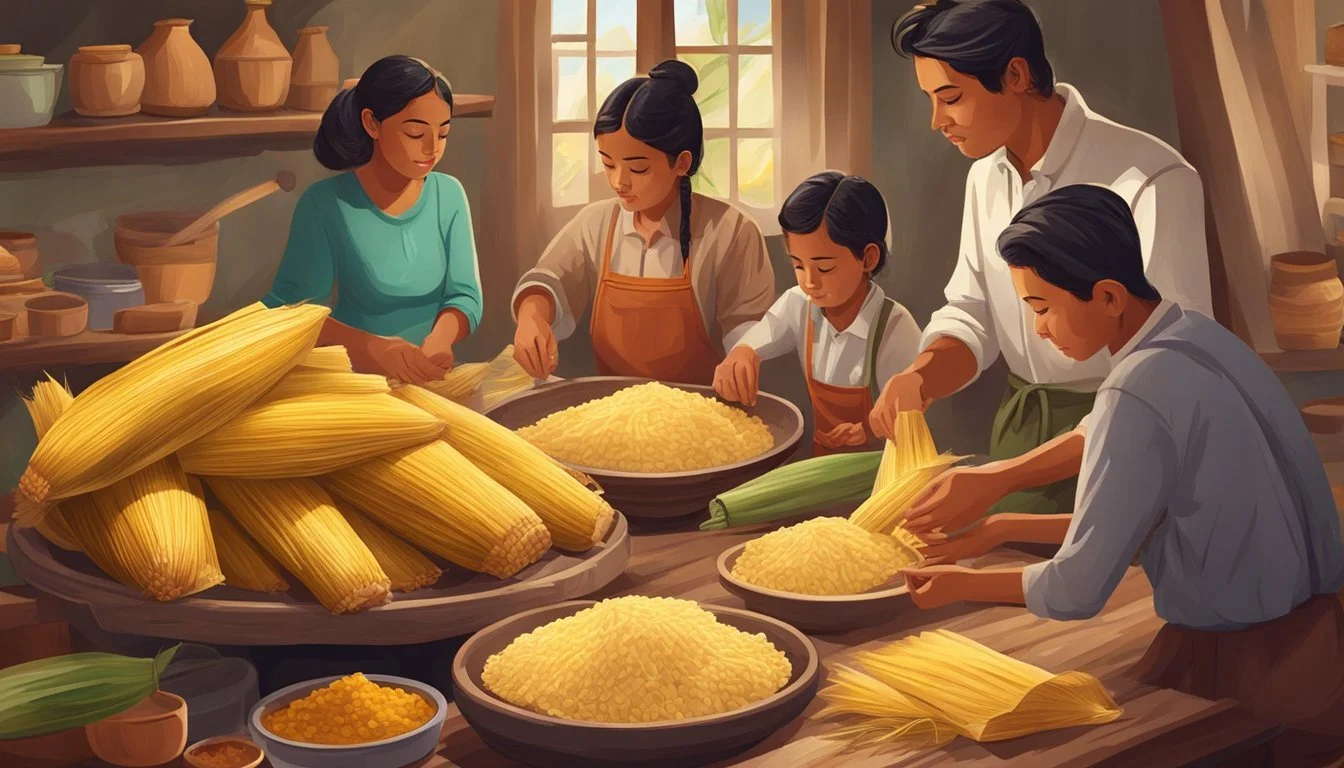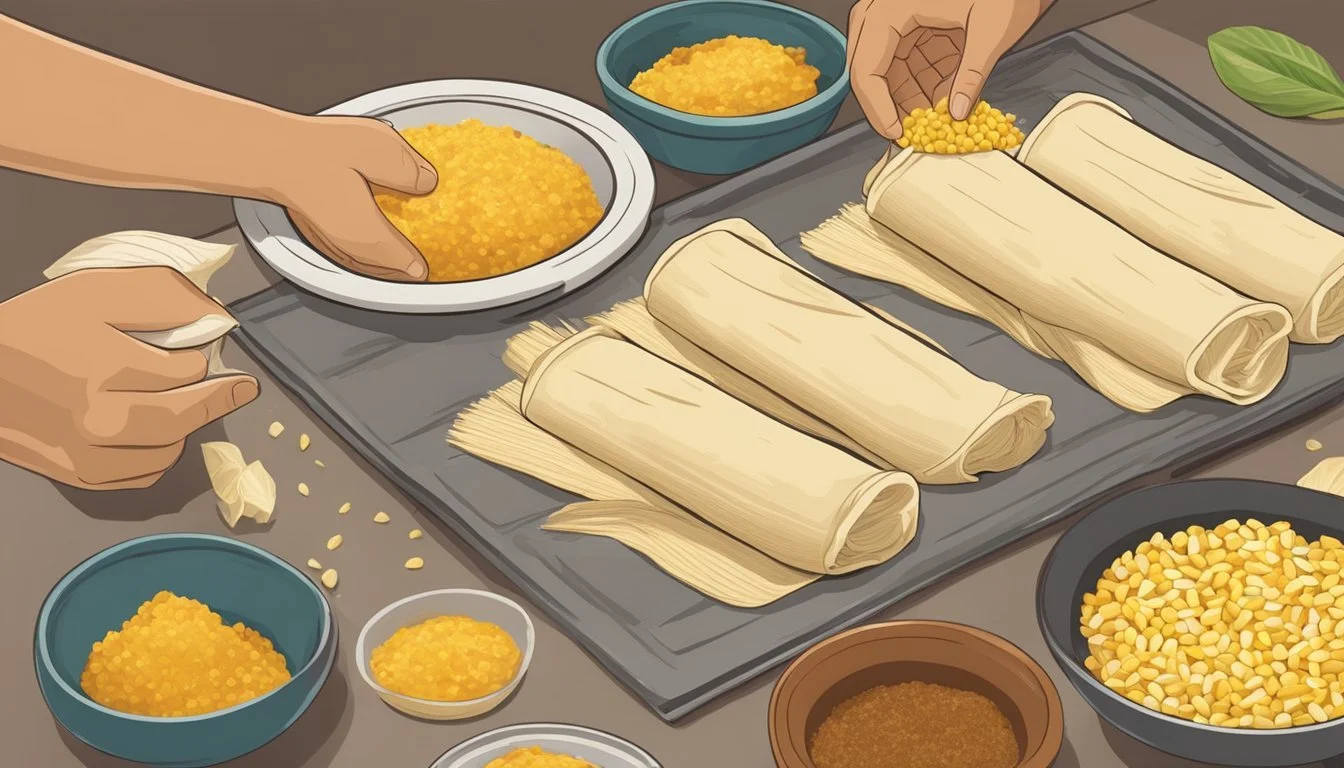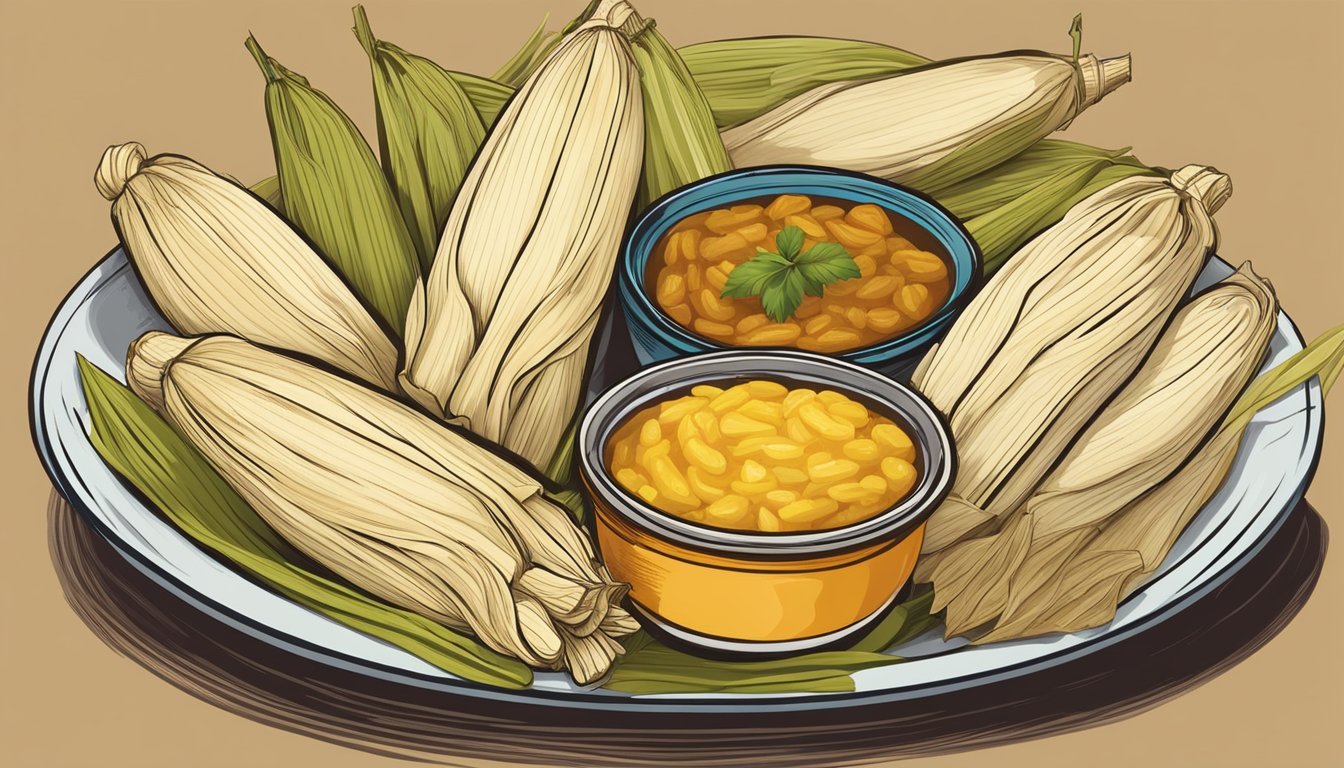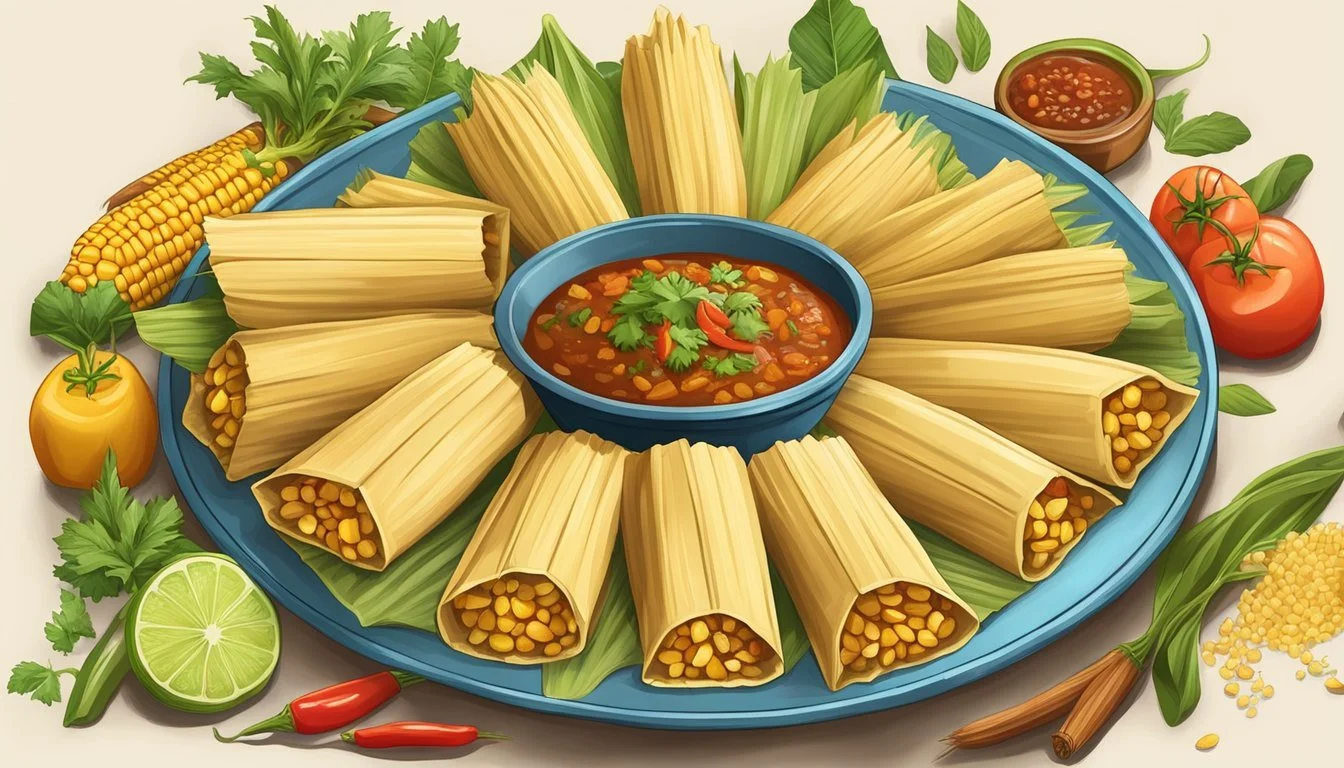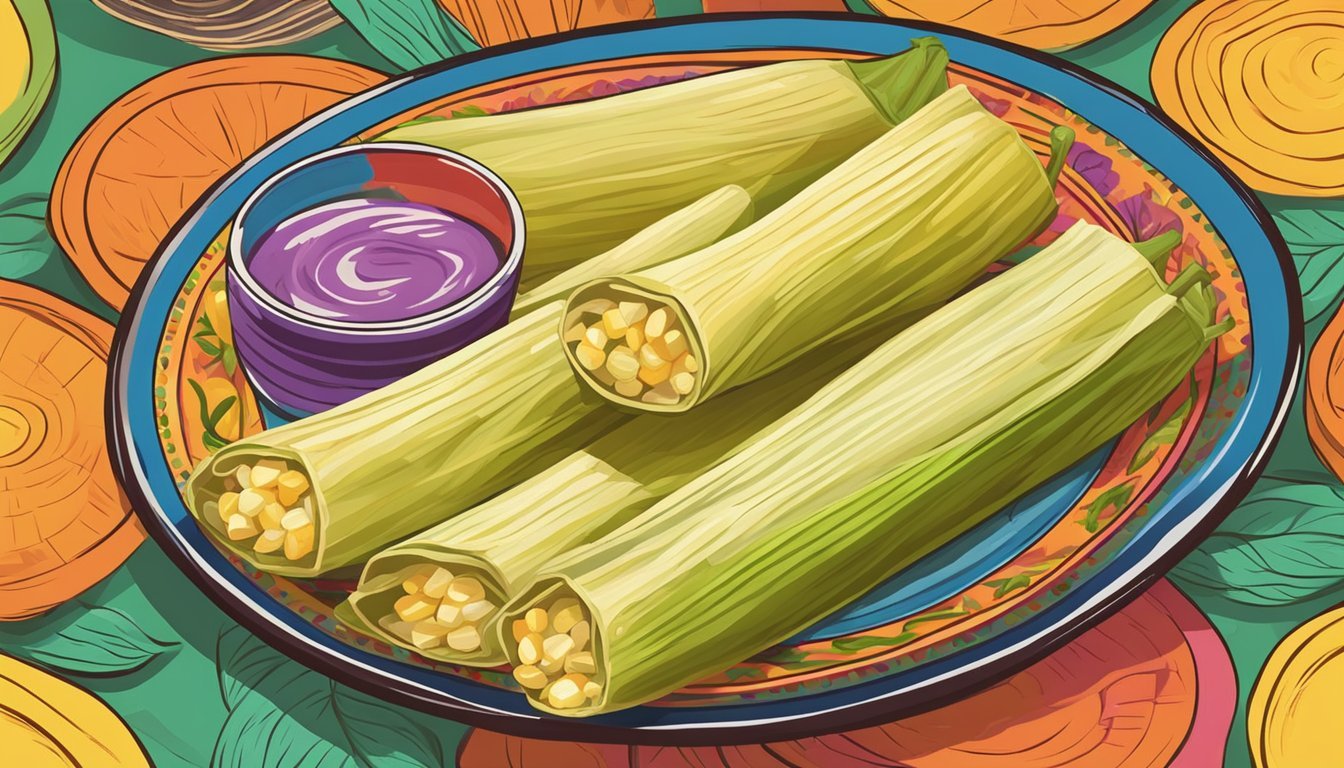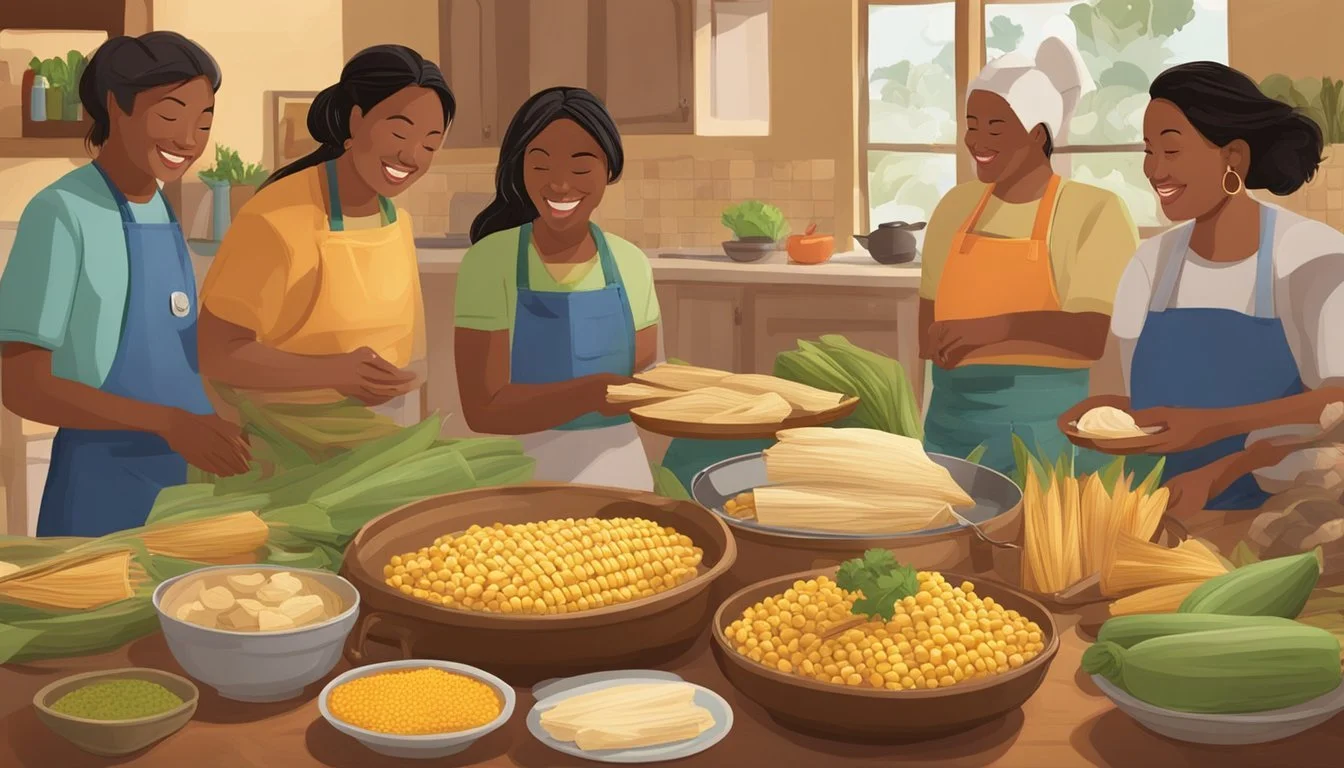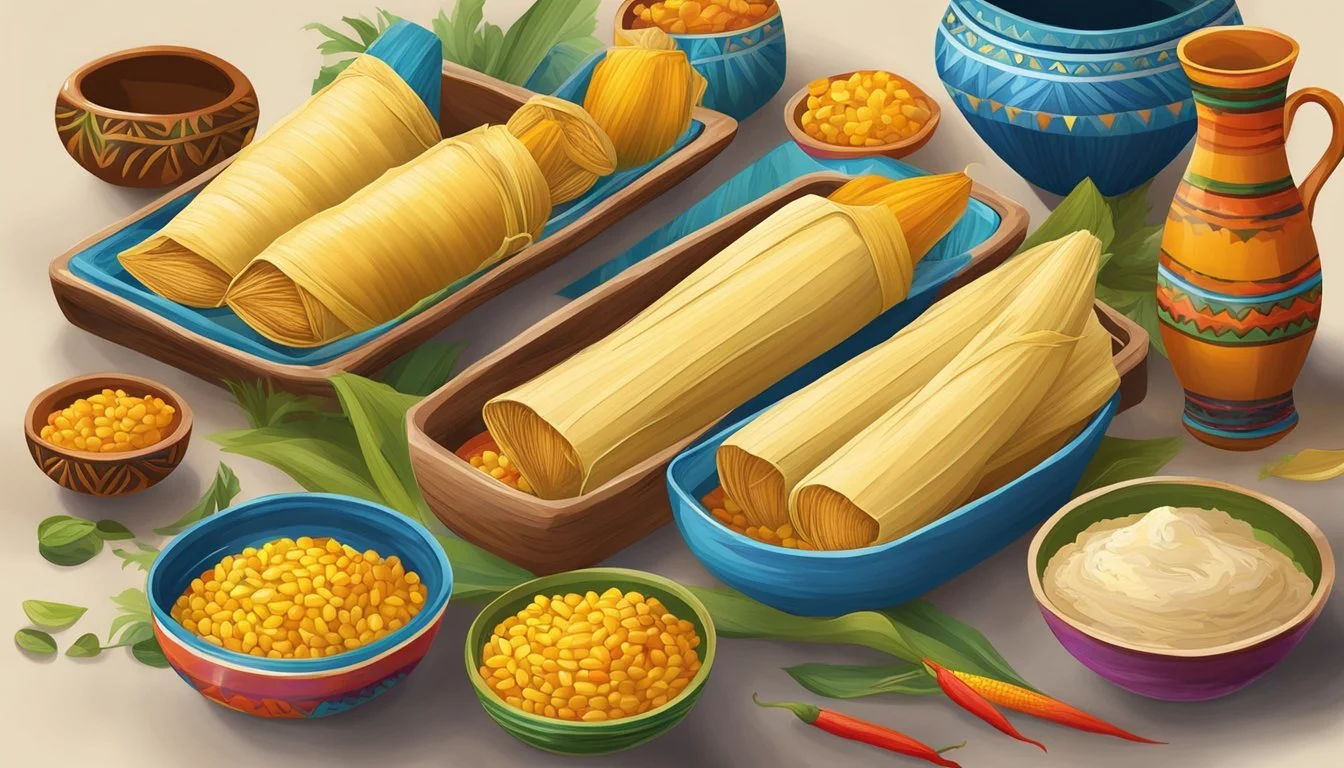Corn Husk Tamales
Unwrapping the Richness of Mexico's Culinary Heritage
Corn husk tamales stand as a testimonial to the rich culinary traditions of Mexico, embodying the essence of flavor and heritage. Each tamale is a parcel of meticulously prepared masa dough, filled with an array of savory ingredients and wrapped in a natural corn husk. This method of enwrapping not only infuses the tamales with a subtle, earthy aroma but also serves as an ingenious cooking vessel that has been utilized for generations.
The preparation process of corn husk tamales is as much about the recipes passed down through families as it is about the communal activity of making them. Typically filled with seasoned meats, cheeses, or chilies, these tamales are a beloved dish enjoyed during festive occasions and everyday meals alike. The dough itself, made from masa harina, is expertly combined with broth and lard, then whipped to the perfect consistency to ensure each tamale is fluffy and flavorful upon steaming.
The art of tamale-making echoes the cultural significance and the labor of love involved in presenting this traditional Mexican dish. They are not merely food; they are a cultural tapestry woven with flavors that are deeply rooted in Mexican cuisine. The versatility of fillings and the regional variations make corn husk tamales a continually evolving dish, while still retaining the warmth and comfort of its traditional origins.
History and Cultural Significance
Tamales, an iconic component of Mexican cuisine, possess a profound historical legacy. Originating in Mesoamerica as early as 8000 BCE, they were a staple for indigenous cultures such as the Aztecs and Maya. These civilizations crafted tamales with a base of corn dough, adding various fillings, and then wrapping them in leaves for cooking.
During significant festivities, tamales serve as more than just sustenance; they become a symbolic centerpiece, especially during Christmas and New Year celebrations. Families and communities gather for a 'Tamalada,' a social event dedicated to the communal preparation of tamales, reinforcing bonds and traditions.
Authentic Mexican Tamales have been preserved through the ages, evolving while maintaining the core practice of corn dough encapsulation in a husk, followed by steaming. This culinary tradition mirrors the rich tapestry of Mexican heritage, encapsulating the essence of communal dining and festivity.
Historical roots: Found in 16th-century Spanish Conquistadors’ records.
Ingredients: Typically include meats, cheeses, beans, and vegetables.
Cultural significance: Central to social gatherings and traditional ceremonies.
The tamale has transcended its simple ingredients to become a marker of cultural identity. In modern Mexico, it remains an enduring tribute to the nation's rich history and collective spirit.
Key Ingredients
In the preparation of traditional corn husk tamales, the choice and quality of key ingredients play a pivotal role in defining the flavor and texture of this beloved Mexican dish.
Corn Husks and Masa
To begin, corn husks are essential for wrapping tamales, providing a natural container that imparts a subtle aroma during the cooking process. They must be soaked to become pliable before use. The masa, a dough made from nixtamalized corn flour (masa harina), acts as the base of the tamale. For a standard batch, one needs approximately 2 cups of masa harina, which is mixed with a liquid such as chicken or vegetable broth, to achieve the right consistency.
Filling Choices
Tamales can be filled with a wide array of ingredients, catering to various tastes. Traditional fillings include pork, chicken, beef, and cheese. The meat is typically cooked and shredded before being added to the tamale. Vegetarian options may include a mixture of vegetables or beans. The filling is placed at the center of the masa before the tamale is folded and wrapped.
Seasonings and Spices
The flavor profile of tamales is heavily influenced by the seasonings and spices used. Common seasonings include salt, garlic, cumin, and pepper. These are added to both the masa and the filling to enhance flavor. A balance of spices is vital to achieving the signature taste of authentic tamales. The masa dough is traditionally combined with lard or vegetable shortening, but health-conscious cooks might opt for vegetable oil or olive oil as alternatives.
Preparing the Corn Husks
Before embarking on the tamale-making journey, one must prepare the dried corn husks that will wrap the savory filling. It is important to properly clean and hydrate these husks to ensure they are flexible and ready for use.
Initial Cleaning:
Separate the dried corn husks, gently unstacking them to remove any debris or dust.
Rinse the husks thoroughly under warm water, making sure to wash each one individually.
Hydration Process:
Fill a large container or sink with hot water.
Submerge the corn husks completely, ensuring they are well-covered by the water.
Weigh down the husks with a heavy object to keep them submerged.
Timing for Soaking:
Allow the corn husks to soak for 30 minutes to 2 hours or until they have become pliable.
After the husks have been properly soaked and softened, they should be drained from the water. One must take extra care to perform the following steps:
Remove the husks from the water and place them in a colander to drain.
Gently shake off excess water and pat the husks dry with a clean towel.
Preparing for Use:
If the husks are too wide, trim them to the desired size that will be easy to fold and roll.
Now that the corn husks are pliable and dry, they can be layered with tamal dough and filling, ready to be rolled and steamed.
The process of steaming will cook the tamales thoroughly. It typically takes about 20 minutes, depending on the size and thickness of the tamales. Preparing the corn husks is a fundamental step in achieving the perfect tamale—a delightful staple of Mexican cuisine.
Making the Masa Dough
Creating the masa dough is a crucial step in tamale making, involving the combination of masa harina and a mixture of fats and broth which are essential for achieving the right texture and flavor.
Mixing the Masa
One begins by taking a large bowl and combining masa harina, baking powder, and salt. Masa harina is the dried corn dough flour that forms the base of the dough. Baking powder is added to the dry mixture to provide leavening, which will help the tamales have a lighter texture.
Adding Broth and Fats
Next, a liquid such as chicken, beef, or vegetable broth is incorporated to moisten the masa harina and bring the dough together. This step creates a pliable consistency crucial for wrapping and steaming the tamales. Fats like lard, shortening, or vegetable shortening are then beaten until they're fluffy, which can take about three to five minutes using an electric mixer. Oil can be used as an alternative to solid fats, especially for those seeking a lighter version. The fat is mixed with the masa until it is well integrated, resulting in a dough that's soft and spreadable without being sticky.
Filling and Flavors
Tamales offer a rich tapestry of tastes, with fillings ranging from savory meats and cheeses to sweet dessert variations.
Meat Variations
Traditionally, tamales are stuffed with a range of succulent meats. Pork filling is a classic choice, often prepared as shredded pork that's been slow-cooked and seasoned with a blend of Mexican spices. Chicken and beef are also widely used, each bringing its unique flavor and texture to the dish. Chicken tamales often incorporate a green or red salsa, while beef tamales might feature a hearty, chili-based sauce.
Vegetarian and Vegan Alternatives
Cheese, such as queso fresco, offers a delectable vegetarian filling, frequently accompanied by vegetables like roasted poblano peppers or mushrooms. Vegan tamales discard animal products entirely, instead embracing an assortment of seasoned vegetables, beans, and possibly meat substitutions made from plant-based ingredients to replicate traditional flavors.
Dessert Tamales
Tamales venture beyond the savory, with sweet tamales constituting a delightful end to a meal or a treat on their own. These dessert tamales often blend sweetened masa with fruits, nuts, and sometimes chocolate or cinnamon, creating a sweet, indulgent experience that stands in contrast to their savory counterparts.
Assembling and Cooking
In crafting traditional corn husk tamales, meticulous assembly and proper cooking techniques are crucial for achieving the authentic taste and texture prized in this Mexican dish.
Folding Techniques
One begins assembly by spreading a spoonful of masa dough on a softened corn husk. For the filling, seasoned pork shoulder is a common choice, though one can utilize other meats, beans, or cheese. It’s essential to leave room at the edges of the husk to ensure a tidy fold. Once the filling is centered on the masa, the husk is folded in half vertically, with the masa completely encasing the filling. The sides of the husk are then brought together, and the narrower end is folded up, creating a closed bundle. The folded tamale can be secured with a strip of corn husk to prevent it from opening during the steaming process.
Step One: Spread masa on husk, add filling.
Step Two: Fold husk vertically, encase filling with masa.
Step Three: Bring sides together, fold narrow end up.
Step Four: Secure with a strip of husk.
Instead of corn husks, some may prefer banana leaves for their aromatic contribution. The folding technique remains similar, although the larger size of banana leaves may require different handling to ensure the tamale is well-wrapped.
Steaming Process
The tamales are then cooked in a steamer. This could be a traditional steamer basket or a modern kitchen appliance such as an Instant Pot or other pressure cookers. The tamales are placed standing on end, ensuring they are not packed too tightly to allow for the expansion of the masa.
Steaming Method Approximate Time Note Traditional Steamer Basket 60-90 minutes Check water level, add as needed. Instant Pot / Pressure Cooker 25-30 minutes Use manual setting; natural release.
The lid should fit snugly to keep the steam trapped. A vigorous steam over consistent heat is key for the tamales to cook evenly, which typically takes around an hour or more, depending on the filling and size. The tamales are done when the masa is firm and pulls away from the husk effortlessly. After the cooking is complete, tamales should rest to allow the flavors to meld and the masa to firm up before serving.
Serving and Accompaniments
When presenting tamales, choosing the right sides and garnishes can enhance the dining experience. Traditional sides offer a balance of textures and flavors, while a variety of sauces and toppings can elevate the simple tamale to a more complex dish.
Traditional Sides
Refried Beans: A creamy and savory side that complements the richness of tamales.
Mexican Rice: Often seasoned with tomatoes and vegetables, this side adds a fluffy texture.
Cactus Salad (Ensalada de Nopales): Provides a crunchy and refreshing contrast to the soft tamales.
Roasted Vegetables: Including zucchini and carrots, roasted to bring out their natural sweetness.
Sauces and Toppings
Guacamole: A creamy avocado-based sauce that adds a cool and rich flavor.
Red Chile Sauce: Made from guajillo or ancho chiles, this sauce brings a smoky heat.
Salsa: Can range from sweet to fiery, often featuring tomatoes as the base.
Pickled Red Onion: Adds a tangy crunch as an accent.
With these accompaniments, tamales can be enjoyed in various ways, keeping meals exciting and flavorful.
Nutritional Information
Tamales, a traditional Mexican dish, encompass a variety of nutritional values depending on their fillings and size. At their core, they consist of masa, a dough made from nixtamalized corn, combined with either cheese, meats, fruits, or vegetables, and are then wrapped in a corn husk or banana leaf before being steamed.
A typical chicken or pork tamale ranges between 250 to 300 calories per serving. The calorie content may increase with the addition of cheeses, creams, and certain meats. Conversely, vegetable-filled tamales tend to be lower in calories, making them a lighter option. The masa itself is a source of carbohydrates, with a standard serving providing around 20 to 30 grams of carbs.
Below is an approximate nutritional breakdown of a standard medium-sized chicken tamale:
Nutrient Amount Calories 250-300 kcal Protein 10-15 g Carbohydrates 20-30 g Fats 10-20 g Fiber 2-4 g
It is important to note that these figures can vary widely. Tamales made with lard will typically contain more fats, whereas those made with vegetable shortening may have less saturated fat. Additionally, the use of whole corn in the masa adds a modest amount of fiber to the dish.
For those monitoring their nutritional intake, tamales can be a part of a balanced diet when consumed in moderation and can provide a good balance of macronutrients when coupled with healthy fillings like lean meats, beans, and fresh vegetables. As with any traditional dish, variations abound, and so do their nutritional profiles.
Storage and Reheating Tips
Corn husk tamales, a beloved traditional Mexican dish, require proper storage and reheating methods to preserve their flavor and texture. It's essential to understand how to keep tamales fresh when stowing leftovers and the best reheating techniques to enjoy them as if they were just made.
Refrigeration
Tamales should be stored in the refrigerator if they are to be consumed within a few days. They need to be kept in airtight containers or tightly wrapped in plastic wrap to maintain moisture. Refrigerated tamales will generally last for up to one week.
Duration: Up to 1 week
Container: Airtight container or plastic wrap
Freezing Methods
For long-term storage, freezing is the best option. Tamales can be frozen for several months without losing quality. One should wrap each tamale individually in plastic wrap, then place them into a freezer bag or airtight container before storing them in the freezer.
Packaging: Individual plastic wrap, then into a freezer bag
Shelf Life: Up to 6 months
Reheating Options
When it comes to reheating, there are multiple methods that one can use to ensure that tamales are moist and delicious:
Steaming: This is the traditional method that maintains the tamales' original texture. Reheat them in a steamer for about 15-20 minutes, or until their internal temperature reaches 165°F.
Oven: Preheat the oven to 325°F. Wrap tamales in aluminum foil and heat for about 20 minutes if thawed, or 30-45 minutes if frozen.
Microwave:
For a quick method, use a microwave. Wrap the tamales in damp paper towels and place them on a microwave-safe plate.
Heat on high for 1-2 minutes per tamale, checking their temperature for completeness.
Reheating methods such as using a sous vide setup or grilling are also available, but they are not as common. Regardless of the method, the goal is to bring tamales to the USDA recommended internal temperature of 165°F to ensure they are safe to eat.
Finding Ingredients
When preparing to make Corn Husk Tamales, sourcing quality ingredients is essential for achieving the authentic flavors of this traditional Mexican dish. Most of the necessary items can be typically found in a local grocery store or a specialized Latin American market.
The primary component of tamale dough is masa flour, a type of corn flour treated with lime or calcium hydroxide. A popular brand that is widely available is Maseca, known for its consistency and quality in making tamal dough.
For the liquid base, vegetable broth is a standard option for mixing with the masa flour, contributing to the moisture and flavor of the dough. Choose a broth brand with a sodium level that suits your taste or dietary needs.
The rich, distinctive sauce often found in tamales originates from red chile. Varieties of chiles used in traditional recipes include Ancho, Guajillo, or Pasilla. Look for dried chiles that are flexible and glossy, indicating they are fresh and of good quality.
Here's a simplified checklist for gathering tamale ingredients:
Corn Husks: Ensure they are intact and pliable.
Masa Flour: Maseca or another reputable brand.
Vegetable Broth: Choose low-sodium if preferred.
Red Chile: Ancho, Guajillo, or Pasilla for the sauce.
Fresh Ingredients: Such as pork, chicken, or vegetables for fillings.
Remember to examine the packaging and expiration dates for freshness. With these ingredients at hand, one can begin the satisfying process of making homemade tamales.
Tips for Hosting a Tamalada
A Tamalada is a social event centered around the preparation and enjoyment of tamales. When planning a Tamalada, it's not just about the cooking—it's about bringing people together for a shared cultural and culinary experience.
Before the Event:
Prep Time: Allocate a day for preparations before the guests arrive. This may include making the masa (tamale dough) and soaking the corn husks.
Assign guests to bring various fillings or appetizers to ensure a variety of flavors and to spread out the workload.
During the Event:
Cook Time: Cooking tamales can take about 25-35 minutes at 375°F (190°C) once they’re assembled.
Provide clear stations for assembly with components laid out in sequence: corn husks, masa, fillings, and then a space for wrapping.
Efficient Workflow:
Station Task Note 1. Corn Husks Soak corn husks for flexibility. At least two hours prior to ensure they are pliable. 2. Masa Prepare and season the masa. Set aside in a container for easy access. 3. Fillings Organize fillings for easy guest access. Consider a variety of meat, vegetarian, and sweet options. 4. Assembly Wrap tamales, typically with a corn husk. Instruct guests on properly enclosing the fillings. 5. Cooking Steam the wrapped tamales until masa is firm. Use a steamer pot and monitor to avoid over or undercooking.
After the Event:
Total Time: Factor in assembling and cooking when scheduling your Tamalada; it is often a full-day event.
Remember to consider cool-down time for the tamales—they need to set before serving.
This event doubles as a main course gathering, ensuring that guests not only enjoy the fruits of their labor but also engage in an age-old tradition that is core to Mexican cuisine.
Variations of Tamales
Tamales, a staple of Mexican cuisine, display an impressive diversity from region to region and have evolved with contemporary twists that appeal to modern palates.
Regional Twists
Northern Mexico often sees the use of red meats and robust flavors. Beef and chile are common in tamales here, reflecting the cattle-raising culture. In contrast, Tamales de Rajas, which contain strips of chile and cheese, are found in the central and southern parts of Mexico, combining the heat of the pepper with the creaminess of cheese.
Southern Mexico is known for its use of chicken tamales, often featuring rich and savory mole sauces. Local interpretations may incorporate regional ingredients like plantain leaves instead of corn husks, which infuse the tamales with a distinctive flavor during the steaming process.
Modern Takes
Chefs and home cooks are bringing new flavors to this traditional dish. They preserve the authentic base — corn masa and husks — but incorporate non-traditional fillings such as:
Gourmet proteins: duck, lamb, or seafood
Vegetarian options: zucchini, mushrooms, or soy proteins
Sweet variations: chocolate, fruit fillings, or nuts
These modern takes often aim to cater to a wider audience, including those with specific dietary restrictions or preferences. They also reflect a growing fusion trend within authentic Mexican food, (What wine goes well with Mexican food?) experimenting with ingredients and techniques from other culinary traditions.
Frequently Asked Questions
What is nixtamal?
Nixtamal is the product of a process where corn kernels are soaked and cooked in an alkaline solution, usually limewater, then hulled. This process improves the nutritional value of corn and is a crucial step in making masa harina, which is dried nixtamal ground into flour.
How is corn masa made for tamales?
Masa for tamales starts with masa harina, which is rehydrated with broth or water to form a dough. It's essential that it achieves the right consistency, which should be pliable and slightly spongy. An electric mixer can be used to blend the ingredients until the dough is fluffy and soft.
Can you make tamales without an electric mixer?
While an electric mixer helps to incorporate air and create a fluffy tamale dough, it's not mandatory. One can also mix the masa by hand, which has been the traditional method for generations.
What kind of meat filling can be used for tamales?
Meat fillings for tamales vary widely, with common options including seasoned pork, chicken, or beef. The meat is usually cooked and shredded before being added to the masa.
Should the corn husks be treated before use?
Yes, corn husks need to be soaked in hot water until they are soft and pliable. This is necessary to prevent them from tearing when wrapping the tamales and to make them easier to fold.
Step Tip Hydrating masa harina Use warm broth to add flavor. Beating the dough Aim for a light, airy texture. Preparing meat filling Cook and shred meat for easy filling. Softening corn husks Soak in warm water until pliable.
By addressing these common questions, one secures a solid foundation for preparing traditional corn husk tamales.
Conclusion
Tamales, a staple in Mexican cuisine, have a rich history and are beloved for their versatile flavors and textures. These savory parcels are expertly wrapped in corn husks, which not only serve as a natural container but also add an earthy aroma to the dish. With a variety of fillings ranging from meats to vegetables and even sweet variations, tamales can cater to an array of palates.
Key Facts:
Origin: Traditional Mexican dish
Wrapping: Corn husks impart subtle flavor
Fillings: Meat, vegetables, or sweet ingredients
Cooking Method: Steaming until tender
In preparation, one must soak the corn husks to ensure they are pliable enough for wrapping. The process of assembling a tamale involves spreading a layer of masa on the husk, adding the chosen filling, and then folding it into its distinctive shape. Tamales are then steamed to cook the masa and meld the flavors within.
It is important to emphasize that tamales are not just food; they represent a cultural heritage and are often prepared for special occasions, bringing families together in both making and enjoying them. They reflect the fusion of indigenous and Spanish influences, making tamales a significant part of Mexican gastronomy.
This traditional dish showcases the simplicity of natural ingredients coming together to deliver a satisfying and authentic experience. Tamales continue to be a cherished dish across Mexico and beyond, gaining popularity worldwide for their unique taste and cultural significance.


